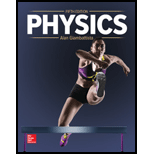
Concept explainers
(a)
At what time does the ball reach its maximum height?
(a)
Answer to Problem 83P
The ball reach its maximum height at
Explanation of Solution
The graph shown plots the velocity-time graph of the ball. When the ball reaches the maximum height, its velocity will be zero there. From the graph at time
Conclusion
Therefore, The ball reach its maximum height at
(b)
For how long is the ball in contact with the floor?
(b)
Answer to Problem 83P
The ball remains in contact with the floor for time of
Explanation of Solution
The graph shown plots the velocity-time graph of the ball. The time for which the ball remains in contact with the floor is equal to the time for which the ball makes a transition from its extreme negative velocity point to extreme positive velocity.
Write the equation to find the time of transition of ball.
Here,
Conclusion:
Substitute
Therefore, The ball remains in contact with the floor for time of
(c)
What is the maximum height reached by the ball?
(c)
Answer to Problem 83P
The maximum height reached by ball is
Explanation of Solution
Write the equation to find the maximum height reached by the rocket.
Here,
Substitute
Conclusion:
Substitute
Therefore, The maximum height reached by ball is
(d)
What is the acceleration of the ball while in the air?
(d)
Answer to Problem 83P
The acceleration of the ball while in the air is
Explanation of Solution
Write the equation to find the acceleration of the ball.
Here,
Conclusion:
Substitute
Since the acceleration is negative, it is acting down wards.
Therefore, The acceleration of the ball while in the air is
(e)
What is the average acceleration of the floor while in contact with the floor?
(e)
Answer to Problem 83P
The average acceleration of the ball is
Explanation of Solution
Write the equation to find the average acceleration of the ball.
Here,
Conclusion:
Substitute
Since the acceleration is positive, it is acting upwards.
Therefore, The average acceleration of the ball is
Want to see more full solutions like this?
Chapter 2 Solutions
Physics
- 20. Two small conducting spheres are placed on top of insulating pads. The 3.7 × 10-10 C sphere is fixed whie the 3.0 × 107 C sphere, initially at rest, is free to move. The mass of each sphere is 0.09 kg. If the spheres are initially 0.10 m apart, how fast will the sphere be moving when they are 1.5 m apart?arrow_forwardpls help on allarrow_forwardpls help on thesearrow_forward
- pls help on all asked questions kindlyarrow_forwardpls help on all asked questions kindlyarrow_forward19. Mount Everest, Earth's highest mountain above sea level, has a peak of 8849 m above sea level. Assume that sea level defines the height of Earth's surface. (re = 6.38 × 106 m, ME = 5.98 × 1024 kg, G = 6.67 × 10 -11 Nm²/kg²) a. Calculate the strength of Earth's gravitational field at a point at the peak of Mount Everest. b. What is the ratio of the strength of Earth's gravitational field at a point 644416m below the surface of the Earth to a point at the top of Mount Everest? C. A tourist watching the sunrise on top of Mount Everest observes a satellite orbiting Earth at an altitude 3580 km above his position. Determine the speed of the satellite.arrow_forward
- pls help on allarrow_forwardpls help on allarrow_forward6. As the distance between two charges decreases, the magnitude of the electric potential energy of the two-charge system: a) Always increases b) Always decreases c) Increases if the charges have the same sign, decreases if they have the opposite signs d) Increases if the charges have the opposite sign, decreases if they have the same sign 7. To analyze the motion of an elastic collision between two charged particles we use conservation of & a) Energy, Velocity b) Momentum, Force c) Mass, Momentum d) Energy, Momentum e) Kinetic Energy, Potential Energyarrow_forward
 College PhysicsPhysicsISBN:9781305952300Author:Raymond A. Serway, Chris VuillePublisher:Cengage Learning
College PhysicsPhysicsISBN:9781305952300Author:Raymond A. Serway, Chris VuillePublisher:Cengage Learning University Physics (14th Edition)PhysicsISBN:9780133969290Author:Hugh D. Young, Roger A. FreedmanPublisher:PEARSON
University Physics (14th Edition)PhysicsISBN:9780133969290Author:Hugh D. Young, Roger A. FreedmanPublisher:PEARSON Introduction To Quantum MechanicsPhysicsISBN:9781107189638Author:Griffiths, David J., Schroeter, Darrell F.Publisher:Cambridge University Press
Introduction To Quantum MechanicsPhysicsISBN:9781107189638Author:Griffiths, David J., Schroeter, Darrell F.Publisher:Cambridge University Press Physics for Scientists and EngineersPhysicsISBN:9781337553278Author:Raymond A. Serway, John W. JewettPublisher:Cengage Learning
Physics for Scientists and EngineersPhysicsISBN:9781337553278Author:Raymond A. Serway, John W. JewettPublisher:Cengage Learning Lecture- Tutorials for Introductory AstronomyPhysicsISBN:9780321820464Author:Edward E. Prather, Tim P. Slater, Jeff P. Adams, Gina BrissendenPublisher:Addison-Wesley
Lecture- Tutorials for Introductory AstronomyPhysicsISBN:9780321820464Author:Edward E. Prather, Tim P. Slater, Jeff P. Adams, Gina BrissendenPublisher:Addison-Wesley College Physics: A Strategic Approach (4th Editio...PhysicsISBN:9780134609034Author:Randall D. Knight (Professor Emeritus), Brian Jones, Stuart FieldPublisher:PEARSON
College Physics: A Strategic Approach (4th Editio...PhysicsISBN:9780134609034Author:Randall D. Knight (Professor Emeritus), Brian Jones, Stuart FieldPublisher:PEARSON





